RECOIL OFFGRID Preparation Cannon in B Minor: Beretta 1301 Tactical Refreshes the Defensive Shotgun
In This Article
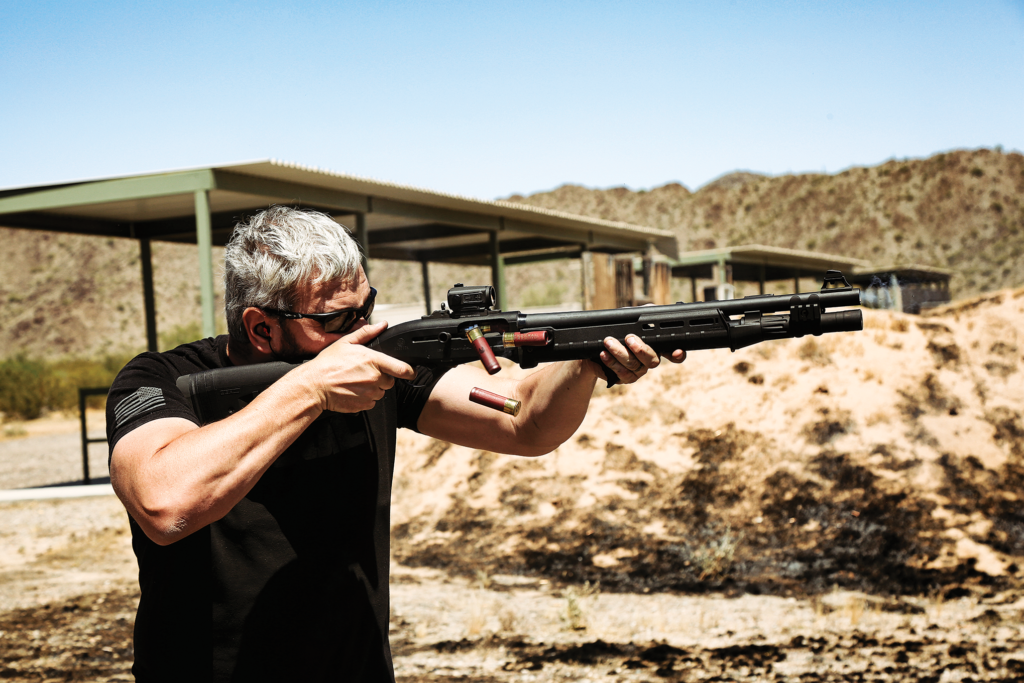
Street Howitzer. Room Broom. Scattergun. Gauge. Twelve Iron. Brixton Typewriter. These are just some of the slang terms for one of the most misunderstood defensive weapons of the 21st century — the self-defense shotgun. For many younger or newer shooters, this class of firearm has been almost entirely written off in favor of short-barreled rifles, rifle-caliber “pistols,” and pistol-caliber carbines. This phenomenon isn’t without good reason. Low recoil, high capacity, faster reloads, and a myriad of aftermarket accessories make these alternatives highly attractive to both the novice and aficionado alike. When measured against pump-action guns, the rate of fire also becomes a factor. And then there are the aggressive options like the Beretta 1301.
But the shotgun isn’t without its own advantages. Firepower per trigger press is going to be hard to beat. There’s also the ability to run buckshot, birdshot, slugs, and almost anything in between depending on your needs and ballistic preferences. Finally, the ability to put multiple “rounds” on target at once is a highly attractive proposition. To put this last point in concrete terms, a standard law enforcement duty load of 00 buckshot is nine pellets. Each pellet is .36 caliber, or just over 9 millimeters at a muzzle velocity typically between 1,100 and 1,200 feet per second. That means each time you fire a shell, you’re sending nine rounds of 9mm — more than a full magazine out of some micro-sized carry pistols — to the target at the same time.
Like the rest of the firearms industry, shotgun technology hasn’t stood still. While often overshadowed by rifle and pistol news, there are companies out there putting hard work into innovating the fighting shotgun. One of these is Beretta — a cornerstone of the high reputation that Italian shotguns have garnered across the globe. We were able to get our hands on a sample of their current premier entry, the Beretta 1301 in the tactical shotgun market, and put it through its paces, not just for performance, but for potential customization as well.
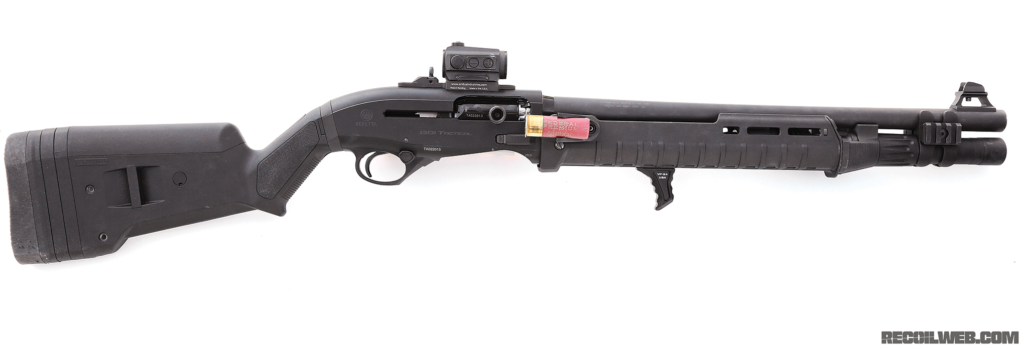
While primarily known for their competition shotguns, Beretta’s no stranger to police and military arms. In the late 1980s, they came out with the 1201FP as a law enforcement-specific variant of their earlier model 1200 sporting shotgun. The 1201FP used an inertia-driven design that’s still seen in combat shotguns today. Then, around 2009, they introduced the TX4, which featured the longer receiver of the 1301 Competition but the sighting configuration of the Beretta 1301 Tactical — that wouldn’t actually come to the market until 2013. One of the most attractive features of the 1301 is its BLINK gas system. As previously stated, most semi-automatic shotguns destined for the duty market use inertia-based cycling systems. Conventional wisdom is that gas systems on shotguns are picky and unreliable and cannot handle transitions between lightweight training or less-lethal loads and full-power buckshot, slug, or door-breacher loads. The trade-off is that inertia systems transfer the bulk of recoil directly back to the shooter. Recoil is a hefty shove and multi-shot strings can lead to muzzle rise that has to be wrestled back down.
Beretta’s BLINK system has a couple of unique features that overcome these problems. The gas piston itself has a self-cleaning design as well as a semi-self-regulating split ring gas seal. The gas valve is also self-regulating, meaning the cycle speed, reliability, and recoil impulse all remain constant despite the pressure differences between ammunition types. In theory, the result is a softer, faster-shooting scattergun that can transition between lightweight bird loads and car-crushing slugs as fast as you can … blink.
Since modularity is a historical Achilles’ heel for shotguns as a class, we wanted to explore the aftermarket potential for the 1301 Tactical. Our multiple searches kept bringing us back to one place: Aridus Industries. Adam Roth, the founder of Aridus, built his company on an idea for a better ammo carriage system for his shotgun: the Quick Detach Carrier, or QD-C. We’ll talk more about the QD-C later, but the company eventually grew its product line out into a suite of unique products for the 1301 Tactical. We were fortunate enough to get our hands on most of them.
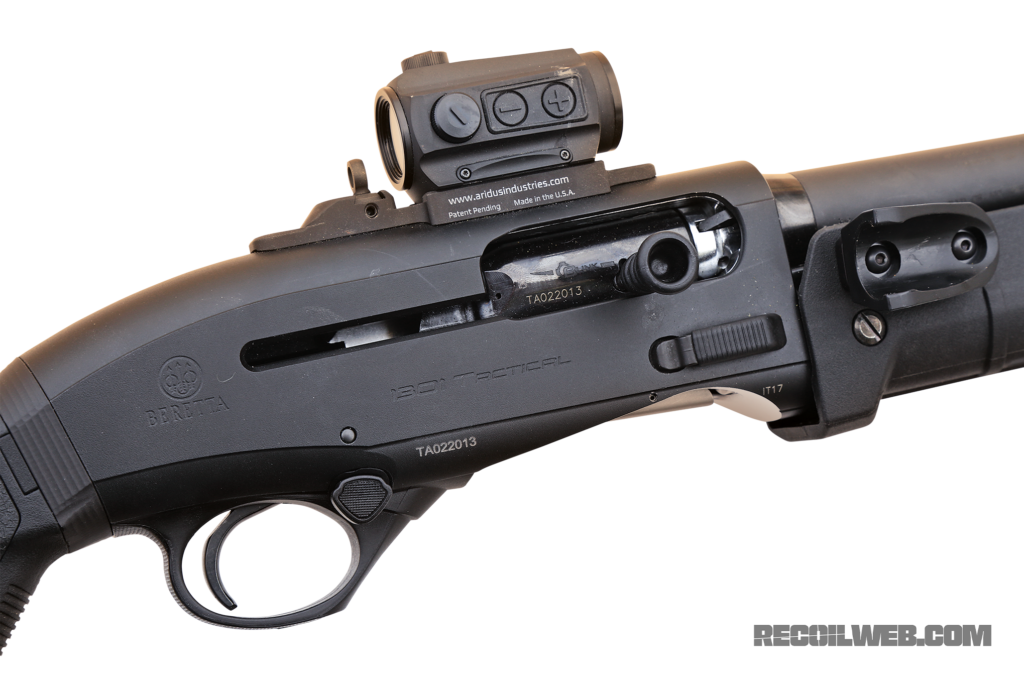
We started with a furniture swap. Aridus Industries sells a receiver adapter plate that allows you to remove the factory stock and replace it with the Mossberg variant of Magpul’s SGA stock. These stocks are inexpensive and use a spacer system to create a significant amount of adjustment in both length-of-pull and cheek comb height. It’s also available in several different colors.
Aridus Industries also produces a forend that uses a modified version of Magpul’s Zhukov AK rifle handguard, and an adapter to fit it over a shotgun magazine tube. With this handguard in place, we were then able to mount M-LOK accessories. Specifically, we put on a SureFire M600 Scout light with Malkoff Devices replacement head in an Arisaka mount and a Vendetta Precision handstop — the latter ensures uniform hand placement at the exact same spot every time we pick up the gun (and keeps it there under recoil). This means we can properly drive the gun while still being able to reach the push-button cap on the Scout light. We actually wound up mounting it backward, as the curvature of the “inside” of the handstop allowed our support hand to slide far enough back that we couldn’t hit the light.
Finally, on the right side of the handguard, we put on a Stage Saver shell holder from TACCOM 3G. The Stage Saver is a single shell caddy positioned directly in front of the chamber. Originally designed for three-gun competition, the idea is that when the shotgun goes to “slide lock” with the bolt locked in the open position, you simply slide that last shell backward out of the Stage Saver and drop it directly into the chamber. Send the bolt home with the release button, and you’ve got one last quick shot to get out of trouble.
The Beretta 1301 comes from the factory with a polymer Picatinny rail on top of the receiver for mounting optics. It’ll do the job. But the Aridus Industries CROM is a much more elegant solution. The Co-witness Ready Optic Mount is a direct replacement for the receiver rail and has a direct-mount footprint for either an Aimpoint T1-style optic or Trijicon RMR-style optic. We went with the former and topped it with a Holosun 403C. The Aridus mount also has a ghost ring rear sight built-in that’s designed to work with the factory front sight.
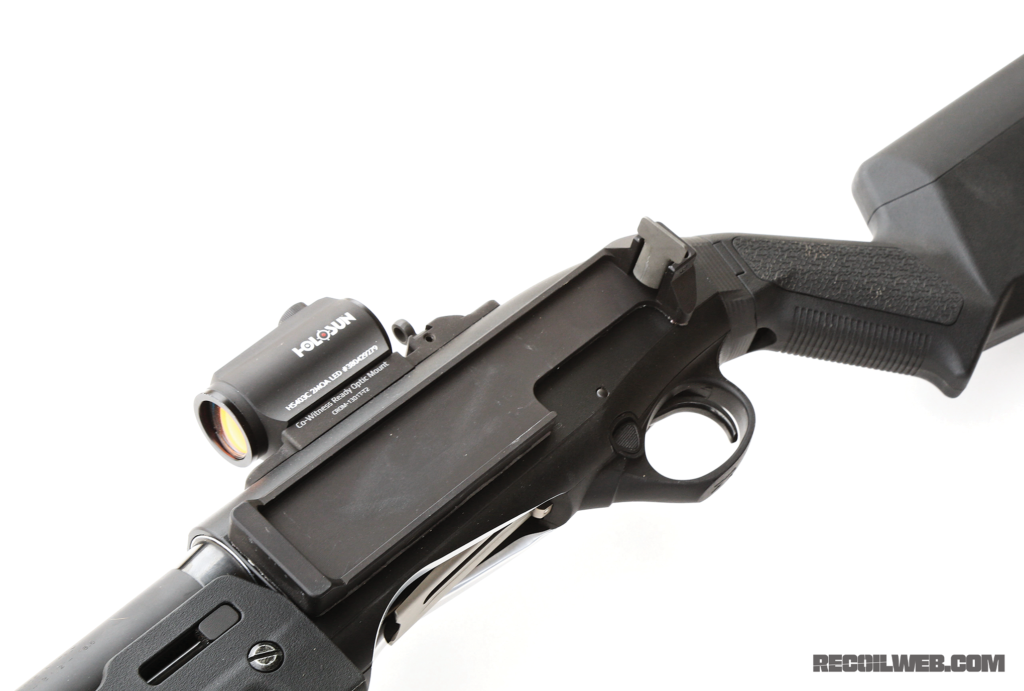
The final piece of Aridus Industries goodness to go on our Beretta 1301 blaster was their flagship Quick Detach Carrier. The idea of a receiver-mounted “side saddle” caddy for extra shells isn’t new. The idea of a detachable or removable carrier isn’t new either — we’ve seen at least two versions that use Velcro to attach soft-loop caddies to the side of the receiver. What sets the QD-C apart is its novel cassette-style shell holder that clicks securely into place with a spring-loaded latch on the receiver-mounted plate. Removing it is as easy as unbuckling a seatbelt. The metal carrier won’t stretch out and deform over time like elastic loops. The spring-loaded latch won’t wear out or cake with mud, dust, or lint like hook-side Velcro. And you can order multiple carriers (they even sell a 10-pack of them!) to keep stashed in your car, load-bearing kit, rucksack, or bugout property. It’s a clever fix for one of the quintessential problems with tube-fed shotguns: capacity. The QD-C, plus the Stage Saver, gives us full reload aboard the gun.
Speaking of capacity, we added a Nordic Components MXT magazine tube extension kit, which gave us an additional two rounds for a total capacity of 7+1 when using 2¾-inch shells. This kit comes with a tube extension, nut, extra length magazine spring, and a barrel clamp that includes a section of Picatinny rail and a quick-detach socket. Finally, we took our test gun to Wright Armory in Mesa, Arizona, to have a clearance cut, radius, and polish job performed on the loading gate. Sometimes referred to as a 3 Gun Mod, the job entails removing material from the front and either side of the receiver around the loading gate. The result is an angled, funnel-shaped contour that enables faster reloads.
We now had an autoloading 12-gauge that’s self-regulating and self-cleaning, equipped with an optic, white light, handstop, and enough ammo on board to completely refill the magazine. With a full tube, full QD-C, Stage Saver, and one in the chamber, that’s a total of 15 rounds of 12 gauge on tap without ever having to reach into a pouch or pocket.
So, we took 15 rounds — and then some — and hit the range.
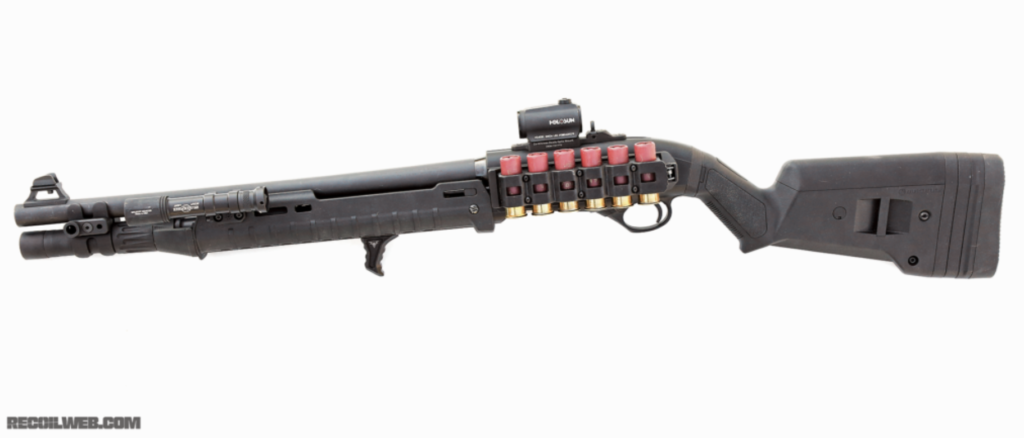
We took our fully appointed Beretta 1301 Tactical to the range with a box full of Federal 12-gauge shells. The bulk of our test ammo was their Law Enforcement 9-pellet 00 buck load, as well as several boxes of their 1.5-ounce rifled slugs. We also had a handful of Hornady Critical Defense buckshot loads. It had been a while since this author had spent any time behind a scattergun. The good news is that all the accessories worked as advertised. We had some concern about the Nordic Components magazine extension, since the included spring had to be cut to fit. The instructions simply said to snip one coil at a time until we were able to fully load the tube. But fully loading and emptying the extended tube nearly a dozen times didn’t show any feeding or reliability issue. As advertised, Beretta’s BLINK gas system puts pellets downrange with a quickness — as fast we could pull the trigger in every case. However, in terms of recoil, the system doesn’t defy physics. Felt recoil, while not nearly as stout as a pump gun, was substantial. The heavy slugs in particular took several tubes to get used to. Then, we had one great run of dropping an entire tube into the burned-out hulk of a sedan before our shoulder was begging for mercy. The LE buckshot loads were noticeably less punishing and, with practice, can be dispensed at will just as fast as you can manage muzzle rise. We suspect (and hope!) that in most situations, as with pomade, “just a dab’ll do ya.”
The shotgun is a niche tool. It always has been and always will be. But there’s also no doubt that a properly kitted scattergun is a staple in any well-rounded home armory. Its capabilities are unique, its reputation near-legendary, and it’s effectively undisputed when applied properly. Fortunately, choosing to put a shotgun in the safe no longer requires you to settle for 19th-century cutting edge. The Beretta 1301 comes out of the box with advanced and proven engineering to optimize reliability and cycle time. Combined with a healthy suite of thoroughly modern accessories like lights and optics, you’ll have an easy-to-use, day-or-night solution to imparting immense amounts of firepower to whatever problem stands in your way.
 STAY SAFE: Download a Free copy of the OFFGRID Outbreak Issue
STAY SAFE: Download a Free copy of the OFFGRID Outbreak Issue
No Comments